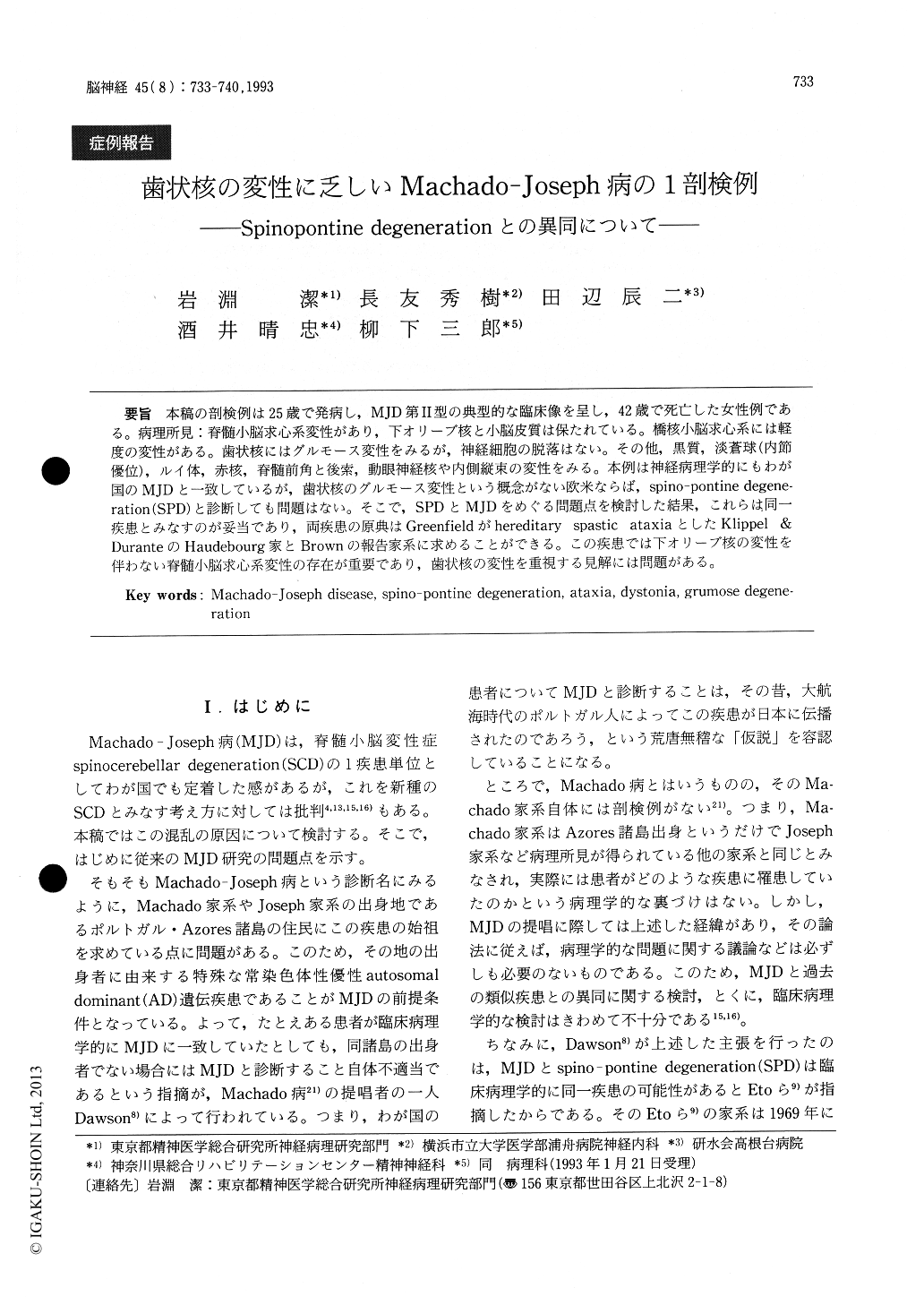Japanese
English
- 有料閲覧
- Abstract 文献概要
- 1ページ目 Look Inside
本稿の剖検例は25歳で発病し,MJD第II型の典型的な臨床像を呈し,42歳で死亡した女性例である。病理所見:脊髄小脳求心系変性があり,下オリーブ核と小脳皮質は保たれている。橋核小脳求心系には軽度の変性がある。歯状核にはグルモース変性をみるが,神経細胞の脱落はない。その他,黒質,淡蒼球(内節優位),ルイ体,赤核,脊髄前角と後索,動眼神経核や内側縦束の変性をみる。本例は神経病理学的にもわが国のMJDと一致しているが,歯状核のグルモース変性という概念がない欧米ならば,spino-pontine degene—ration(SPD)と診断しても問題はない。そこで,SPDとMJDをめぐる問題点を検討した結果,これらは同一疾患とみなすのが妥当であり,両疾患の原典はGreenfieldがhereditary spastic ataxiaとしたKlippel & DuranteのHaudebourg家とBrownの報告家系に求めることができる。この疾患では下オリーブ核の変性を伴わない脊髄小脳求心系変性の存在が重要であり,歯状核の変性を重視する見解には問題がある。
The authors present the clinico-pathological find-ings in a member of a family residing in Akita Prefecture located in the north-eastern region of Japan. Four members in three generations of the family developed ataxia.
The autopsied patient was a 42-year-old woman, who, at the age of 25, had developed progressive cerebellar ataxia with pyramidal spasticity and increased deep tendon reflexes predominant in the lower extremities. However, she retained fine movement of the hands and fingers and showed no dysarthria until the age of 35. She could no longer walk unassisted at 38 years old. She showed cere-bellar ataxia in both hands and legs, dysarthria, bulging eyes, progressive extraoculomotor palsy with nystagmus, bradykinesia, sensory disturbance, and dystonia in the face, upper extremities, and fingers. Deep tendon reflexes were decreased, espe-cially in the lower extremities. Subacute general-ized muscular atrophy developed at the age of 39. She became bedridden and died of pneumonia. The clinical diagnosis was Type-2 of the entity known in Japan as Machado-Joseph disease.
At neuropathological examination, the brain weight was 1,250 g. The spinocerebellar system including Clarke's column and the spinocerebellar tracts were degenerated, but the cerebellar cortexand inferior olivary nucleus were spared. Slight-to -moderate degeneration was observed in the pontocerebellar system. In the dentate nucleus, most of the neurons showed what is known in Japan as "grumose degeneration", but there was no neuronal loss or gliosis. The hilus of the dentate nucleus and the superior cerebellar peduncle were intact. Exa-mination of the extrapyramidal system revealed a marked degeneration in the substantia nigra, sub-thalamic nucleus, and globus pallidus which was predominant in the internal segment. The striatum was spared. The oculomotor nucleus and the medial longitudinal fasciculus were severely affected. Moderate neuronal loss was noted in the hypoglos-sal nucleus and the anterior horn of the spinal cord, and moderate degeneration in the neurons of the dorsal ganglion of the posterior roots, the dorsal column of the spinal cord, the dorsal ganglia of the medulla oblongata, and the medial lemniscus. The cerebrum, white matter, and the thalamus were intact.
Neuropathological study revealed the findings in this patient to be identical with those of MJD. However, the neurons in the dentate nucleus showed grumose degeneration, although no neuronal loss or gliosis was noted there. Many Japanese neuropatho-logists consider grumose degeneration to be a cha-racteristic feature of degeneration of the dentate nucleus, but this concept has not been accepted by the Western investigators. Thus, this patient would be diagnosed there as spinopontine degeneration (SPD) described by Boller and Segarra in 1969. However, recent studies have suggested MJD and SPD are identical to each other clinico - patholo-gically. The results of this study also confirm this perspective.

Copyright © 1993, Igaku-Shoin Ltd. All rights reserved.


